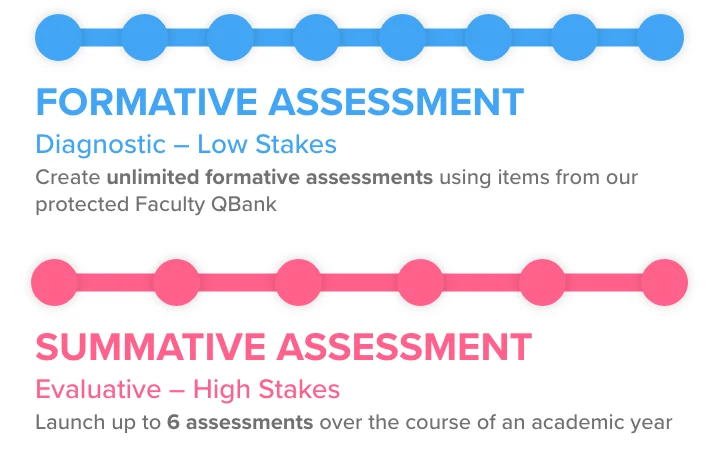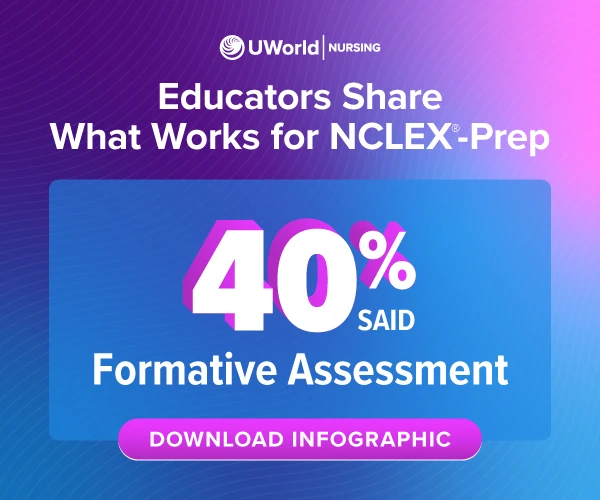There are several different types of assessments that nursing instructors may use to measure their students' progress. Among the most common are summative, formative, and benchmark assessments. We'll explore the strengths and weaknesses of each, as well as their unique benefits for both instructors and students. We'll also discuss how partnering with UWorld Nursing can elevate the effectiveness of your assessments and better prepare your students for NCLEX success.


Formative Assessments in Nursing
Formative assessments are used to identify a student's strengths and weaknesses, allowing for immediate remediation. Unlike other assessment types, these are generally low-stakes and used to aid in the learning process rather than determine a grade.
Pros and Cons of Formative Assessments
Formative assessments are a great diagnostic tool rather than an evaluative one. They can be a tremendous help to both instructors and students in terms of identifying and addressing knowledge gaps. In nursing education, high-quality formative assessments are designed to pinpoint specific areas where individuals, groups, or the entire class need improvement. This targeted feedback helps students strengthen their clinical judgment and understanding, ultimately leading to better patient care.
UWorld Content for Formative Assessments
UWorld University partners can create unlimited formative assessments using classic and NGN items from our QBank. To create a formative assessment, simply select relevant questions based on subject, system, or client needs categories. Just like in our student QBanks, these questions come with detailed explanations to help with remediation. Instructors can also review student performance at an individual and class-wide level.
Familiarizing Students with Adaptive Testing
Students can take unlimited computerized adaptive tests (CAT) practice tests in the self-study area of the Learning Platform. While not true formative assessments, they serve as an excellent preparation tool because they mirror the adaptive conditions of the real NCLEX. Upon completing a UWorld CAT, students receive their overall score, their level of preparedness, and the difficulty factor of the questions they answered. Instructors can also view the results to help with remediation.
Summative Assessments in Nursing
Summative assessments evaluate a student's knowledge of a subject at the end of an instructional period based on a uniform standard (e.g., a midterm or final exam).
Pros and Cons of Summative Assessments
Summative assessments are useful for determining a student's overall understanding of a topic. In nursing, their high-stakes nature can be used as an opportunity to teach productive study strategies and habits in anticipation of the NCLEX. However, summative assessments typically don't give students an opportunity to learn from their mistakes. They can be used to assess the effectiveness of a course or program but are not intended to be diagnostic for students.
UWorld Content for Summative Assessments
Instructors can assign up to six summative assessments with NCLEX-style questions through our Learning Platform for Nursing. Each assessment contains 100 unique NGN and classic questions that cannot be found in our student or faculty QBanks. Upon completion, students can review their answers and read detailed rationales for each question, while instructors can view thorough performance reports.
Maximizing Your UWorld Nursing Assessments
When used correctly, UWorld Nursing assessments are a remarkably powerful remediation and NCLEX preparation tool. Your students will get firsthand experience with NGN-style questions and time constraints, as well as exposure to the most relevant NCLEX topics. Instructors can then identify which students are on track or falling behind. Here's how:
- Assign at least three assessments each semester (or one about every two months)
- Have your students review the answer explanations upon completing each assessment
- View in-depth performance reports to track your students' progress and identify at-risk students
- Based on these results, you can create unique assignments for individuals or groups to turn their weaknesses into strengths
The analytics instructors receive are twofold. First is a breakdown of student performance across subjects, systems, and topic areas. Second is an accurate prediction of each student's chance of passing the NCLEX (low, borderline, high, or very high) based on statistically validated scoring.
What about Benchmark Testing in Nursing?
Benchmark assessments measure a student's progress toward reaching an educational goal over time. Administered in predefined intervals, such as at the beginning and end of a nursing program, educators generally use benchmark assessments to compare their students' understanding against a uniform standard (determined by accrediting bodies).
Pros and Cons of Benchmark Assessments
The greatest benefit of using benchmark assessments is the ability for educators and administrators to compare their students' performance against national standards. A weakness is that benchmark testing requires additional safeguards to ensure results are fair and accurate (e.g., providing a secure or proctored testing environment).
Legislative Changes to Benchmark Testing in Nursing Education
Benchmark testing is a hot topic in nursing education, with compelling arguments for and against the practice. It's important to note that your program may be impacted by legislation limiting the use of benchmark tests created by private entities. Texas is a recent example:
In Fall 2023, the Texas Legislature passed a bill with stricter regulations on standardized examinations used by nursing schools and educational programs. While there are a number of ways standardized benchmark tests can still be implemented, the goal is to prohibit their use as a graduation requirement and minimize their impact on students' grades.
Is There a Best Assessment Type for Nursing Students?
Summative, formative, and benchmark assessments all have their place in nursing education. Because summative and benchmark assessments are evaluative in nature, they can help determine if students are on track with educational objectives; however, formative assessments are better at identifying at-risk students earlier and increasing student engagement in the learning process.
Regardless of your course structure, the UWorld Learning Platform for Nursing can elevate student performance through NCLEX-style questions, detailed reports, and built-in remediation methods. Our resources are flexible and align with the new AACN Essentials, enabling easy integration with any nursing curricula.







